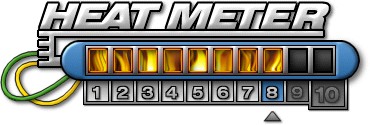|
By
Jeff Bouton
6/12/2001

 |
|
Hub vs. Switch
Overview Continued... |
|
Put On Your Thinking Cap... |
|
One of
the biggest advantages to a switch is its ability
to direct a packet to the destination computer and
not the other components connected to the network.
Using the MAC address of each network card on the
network, the switch directs the packet to the
intended recipient. A MAC address is a unique
identifier incorporated into every NIC.
Scanning each packet for the source and destination MAC
address, the switch can direct
the information to the appropriate machine. As seen below,
Computer A sends a command to Computer C, while
Computer B sends a job to the Network Printer.
Scanning each packet for the MAC address
information, the DSS-5+ switch directs each request
to its intended recipient without allowing the
two to interfere with each other. This allows for an
efficient network design and higher overall
bandwidth.

Because of the switches
design, maximum bandwidth can be maintained even
while multiple machines are sending information
across the network. In the case of the
DSS+5 Switch, five components can be attached, send
information simultaneously, and the information can
travel at a maximum bandwidth of 100Mbps.
 |
|
Hot Hardware's Test Systems |
|
Something Old, Something
New... |
|
|
Test Machine A
Tyan Tsunami S1846 (Intel 440BX) with an Intel PIII @
650MHz.
256MB
of Infineon RAM
Western Digital
8Gig ATA66 5400 RPM Hard Drive
nVidia
GeForce 2 MX 32MB AGP Graphics Card
Sound Blaster Value
Live
Creative 52X CD-ROM
Windows 98SE
Direct
X 8.0a and nVidia reference drivers V.6.50
|
Test Machine B
Shuttle AE23
(Intel i815EP) with an Intel PIII @ 933MHz.
256MB
of Mushkin 2-2-2 Rev. 2 RAM
Western Digital
WD300BB 30Gig ATA100 7200 RPM Hard Drive
nVidia
GeForce 2 Ultra 64MB AGP Graphics Card
Hercules Game
Theater XP
Plextor
PlexWriter 12/10/32
Pioneer
16/40 DVD Rom
Windows Millennium
Direct
X 8.0a and nVidia reference drivers V.6.50
|
Test Machine
C
Compaq Presario 1255
AMD K6-2 - 333MHz.
96MB PC 100 RAM
12GB Western
Digital HD
Neo Magic 128 XD
Video
ESS 1869 Sound
20X CD-ROM
Windows Millennium
Direct
X 8.0a
|
 |
|
The Benchmarks |
|
Short and Sweet... |
|
For our benchmarks,
we've used a handy command line utility called
NetCPS. NetCPS is capable of transferring a
specific amount of data across the network without
utilizing the computers' hard drives. This
enables us to test the network capacity without the
possible bottleneck involved with hard drive
transfer rates, if they exist at all. Below is
an explanation of the tests we ran and the reason
why we ran them.
In Test Scenario 1, Test Machine A is running NetCPS
in server mode. Test Machine B is
configured in client mode with a 500MB transfer
being sent from one to the other (top red line). This is a simple
test to gauge an optimal transfer rating for
comparison with the remaining tests.
In Test Scenario 2, we
used NetCPS to transfer 500MB of data between Test
Machines A & B simultaneously (both red lines). This test gives
an example of the Full Duplex concept and
performance.

In Test Scenario 3, we
used the same setup as the second while also
downloading a 1GB file from Test Machines A & B to
Test Machine C (2 blue lines). This test was
run to cause a fairly heavy amount of traffic and
demonstrate the performance advantages of a Switch
over a Hub.
Our test results list
the average Megabytes per second transfer rate as
well as the total amount of time it took for the
500MB transfer in seconds. Each Scenario was
running using the D-Link DSS-5+ Switch compared to a
Linksys EFAH05W 5-Port Workgroup Hub.
|
Test |
NetCPS Results - Linksys Hub |
NetCPS Results - D-link DSS
5+ |
|
Test Scenario 1 |
8.15MB/s - 61.52 sec |
9.53MB/s - 52.44 sec |
|
Test Scenario 2 |
4.25MB/s - 117.65
sec |
7.89MB/s - 63.37 sec |
|
Test Scenario 3 |
3.85MB/s - 129.87
sec |
6.56MB/s - 76.22 sec |
As you
can see by these performance numbers, the D-Link
DSS-5+ far surpasses the performance of a standard
hub. As traffic increased and the potential for a
collision became greater, as with Test Scenario 3,
the Switch handled the traffic far more effectively
than the Hub. The performance of the HUB dropped
almost 53% while the DSS-5+ dropped 31%. As seen
with the transfer of a 500MB file, Test Scenario 3's time was more than doubled to 129.87 seconds
with a hub, while the overall time increased 24.22
seconds to 76.22 with the switch.
So what does all of this mean to the PC user looking
to set up a home network? First off, if you are one
of the lucky people who has a DSL or Cable internet
connection, this is an excellent option for
networking multiple computers and sharing an
internet connection. With the ability to transfer
large amounts of data, the DFE-910 Network In A Box
will outperform a similar hub-based system. With the
increasing popularity of online gaming and streaming
media, using a switch-based network will ensure
smooth operation even under heavy loads.

The
DFE-910 Network In A Box is an all-around good
product. We have demonstrated the benefits of owning
such a system compared to a hub-based one. The
cost difference between owning a Switch compared to
a Hub should be minimal, and at a price of $119, the
DFE-910 Network In A Box is an excellent choice.
Even though the software included in this package is
quite poor, the documentation provided is top notch.
For excellent quality, documentation, and overall
performance, we give the D-Link DFE910 Network In An
Box a Hot Hardware Heat Meter Rating of an 8.

Are you talkin'
ta me? Get into the HotHardware Conference
Room!
.gif)
|